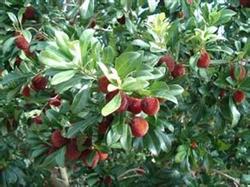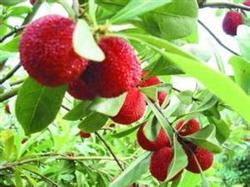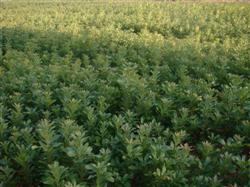Control techniques of root rot of red bayberry

The symptoms are mainly harmful to the root system of red bayberry. After the disease, the main manifestations of the tree are root decay, rapid withering of branches and leaves or yellow withering of leaves. Root rot can be divided into acute wilt type and chronic decay type. Acute Ralstonia solanacearum type: the symptoms are difficult to detect at the initial stage of the disease, and there are obvious symptoms only about 2 months before death. The leaves lost their luster and faded, and some of the leaves in the lower part of the crown turned brown and fell off. in case of high temperature and drought, the top branches of the crown wilted, and at the beginning, the wilted branches could still recover in the next morning. If the temperature rises sharply before and after fruit picking, it often dies rapidly, and the leaf color changes gradually from light green to reddish brown. Young and strong trees under 30 years old have more diseases, accounting for more than 70% of dead trees. Chronic decline type: the spring shoot is normal at the initial stage of the disease, but the new shoot is rarely or not in the autumn, the underground part shows less root nodule, and the fine root gradually turns brown and rotten. In the later stage, the disease aggravated, and the leaves of one branch, half plant or the whole plant turned yellow, less fruit, small fruit and poor quality. In the hot and dry weather, the leaves gradually become reddish brown and dry and fall off, the branches die, half of the tree dies or the whole plant dies. This type mainly occurs in the senescent trees after the full fruiting period. it usually takes 2-3 years from the appearance of symptoms to the death of the whole plant, and less than one year. The pathogen is a kind of fungus distributed all over the world, which belongs to the order Botrytis cinerea, the synonym is Camellia tenuiformis, and the asexual stage is the small burrow shell fungus of Sporospora. Control measures (1) promote growing grass in orchard, mowing and covering before high temperature of red bayberry, spring and autumn to protect root system. (2) strengthen cultivation management and disinfect lightly diseased plants with soil exchange, sun-drying or lime to reduce germs. (3) rational fertilization to avoid improper fertilization or excessive fertilization damage to the root system. (4) Pesticide control. For the newly diseased plants, the method of spraying above and below can be adopted, that is, 0.8% lime double Bordeaux solution or 1000 times of dixone can be used on the ground, each plant is 40ml 50kg, or 50% carbendazim or 70% methyl thiophanate 0.25kg per plant is mixed with 0.5 kg rooting powder, while the canopy is repeatedly sprayed with fungicides such as zinc and carbendazim and nutrient solutions such as Fudan Fulong to promote the recovery of diseased plants, but seriously diseased trees are ineffective. (5) excavate the seriously diseased plants in time and burn them centrally. (6) do not mix or adjacent with peach, plum, pear and other fruit trees, because peach and plum are the intermediate hosts of the pathogen of the disease.
- Prev

Key points of Scientific Management of soil and Fertilizer in Waxberry Orchard
The yield of red bayberry mainly depends on the strength of plant growth and the size of tree crown. Therefore, orchard management should be strengthened, especially water and fertilizer management. 1. The red bayberry planted on the hillside is often affected by soil erosion and bare roots. Therefore, the inner slope is used to open ditches in time.
- Next

Cultivation techniques of Myrica rubra
Biological characteristics of plant cultivation: like warm, humid and cloudy climate. Not resistant to strong light, not resistant to cold. It is suitable to plant acid yellow soil with north or east direction, deep soil layer, loose and fertile soil and good drainage. Cultivation techniques: there are many varieties, which can be divided into white, red and pink according to fruit color.
Related
- Moge, come on! The staff of the peasant association in the producing area of cantaloupe were frightened when the crowd gathered.
- Causes and Solutions of low Fruit setting rate of Apple
- Symptoms and control measures of passion fruit virus disease
- Fruit growing lesson: how do apple orchards keep high yields?
- Can you build orchards in the mountains? What are the pros and cons?
- How to manage the coloring period of Crisson grape?
- This paper introduces the processing technology of two kinds of fig products.
- How much is a month for retired teachers in rural areas by 2020?
- How can strawberry planting increase sugar content? We should pay attention to management in many aspects.
- What are the cultivation techniques on how to improve the yield of golden fruit?

